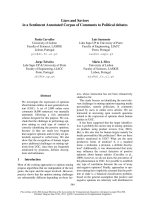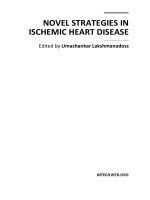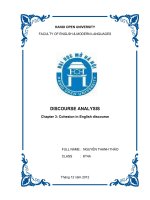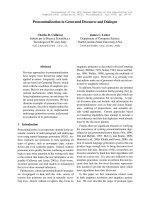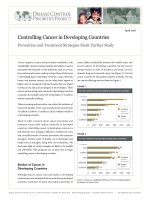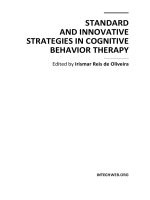Persuasive Strategies In Political Discourse.pdf
Bạn đang xem bản rút gọn của tài liệu. Xem và tải ngay bản đầy đủ của tài liệu tại đây (804.83 KB, 88 trang )
VIET NAM NATIONAL UNIVERSITY, HANOI
UNIVERSITY OF LANGUAGES AND INTERNATIONAL STUDIES
FACULTY OF POST-GRADUATE STUDIES
NGUYỄN THỊ HUYỀN
PERSUASIVE STRATEGIES IN POLITICAL DISCOURSE
(Chiến lược thuyết phục trong diễn ngơn chính trị)
MA THESIS – TYPE 1
Field
: English Linguistics
Code
: 8220201.01
HANOI - 2021
VIET NAM NATIONAL UNIVERSITY, HANOI
UNIVERSITY OF LANGUAGES AND INTERNATIONAL STUDIES
FACULTY OF POST-GRADUATE STUDIES
NGUYỄN THỊ HUYỀN
PERSUASIVE STRATEGIES IN POLITICAL DISCOURSE
(Chiến lược thuyết phục trong diễn ngơn chính trị)
MA THESIS – TYPE 1
Field
: English Linguistics
Code
: 8220201.01
Supervisor : Prof. Nguyễn Hòa
HANOI - 2021
DECLARATION
I hereby declare that this MA thesis namely Persuasive Strategies in Political
Discourse is my own original work and has not been submitted before to any
institutions for assessment purposes.
Further, I have acknowledged all sources used and have cited in the reference
section.
Researcher
Date: December 2021
Nguyễn Thị Huyền
i
ACKNOWLEDGEMENTS
Firstly, I wish to express my sincere gratitude to my thesis supervisor - Prof.
Nguyễn Hòa of the University of Languages and International Studies at Viet Nam
National University for his patience, motivation, and immense knowledge. His
guidance helped me in all the time of doing the research and writing this thesis. I
could not have imagined having a better advisor and mentor for my MA study.
Secondly, I am also grateful of my fellow MA friends for their friendship
and mentally constant support during the time of studying and writing my thesis.
Last but not the least; I express my very profound gratitude to my parents, to
my husband and to my sisters for providing me with unfailing support and
continuous encouragement throughout years of my studying and through the
process of researching and writing this thesis. This accomplishment would not have
been possible without them.
Author
Nguyễn Thị Huyền
ii
ABSTRACT
Hillary Rodham Clinton has been known as an American politician who has
served as the First Lady of the United States, an U.S senator, the Secretary of State,
and a Democratic party’s nominee for President. Hillary became one of the most
prominent First Ladies, who has championed Women and Children’s rights. Among
her passionate finest speeches, the speech on women’s rights in 1995 for me is the
most significant and meaningful.
This research investigates the persuasive strategies used in the speech and
how those strategies worked to bring people around to the speaker’s ideas. The
specific aims of this paper are to reveal the persuasive strategies used in the political
speech identifying the prominent linguistic features used in Hillary’s speech to
impact the audience’s minds.
This research adopts Aristotle theory of persuasion, CDA, and Toulmin’s
model of argument. Lexis, grammar and structure are three linguistic prominence
analyzed in the thesis. The findings of this study are to figure out the sole operation
and mutual combination of persuasive strategies presented as logos, ethos, and
pathos to reassure the close relationship between language and ideology.
iii
C.33.44.55.54.78.65.5.43.22.2.4..22.Tai lieu. Luan 66.55.77.99. van. Luan an.77.99.44.45.67.22.55.77.C.37.99.44.45.67.22.55.77.C.37.99.44.45.67.22.55.77.C.37.99.44.45.67.22.55.77.C.33.44.55.54.78.655.43.22.2.4.55.22. Do an.Tai lieu. Luan van. Luan an. Do an.Tai lieu. Luan van. Luan an. Do an
ABBREVIATIONS
DA
: Discourse Analysis
CDA : Critical Discourse Analysis
SFG : Systemic Functional Grammar
iv
@edu.gmail.com.vn.bkc19134.hmu.edu.vn
C.33.44.55.54.78.65.5.43.22.2.4..22.Tai lieu. Luan 66.55.77.99. van. Luan an.77.99.44.45.67.22.55.77.C.37.99.44.45.67.22.55.77.C.37.99.44.45.67.22.55.77.C.37.99.44.45.67.22.55.77.C.33.44.55.54.78.655.43.22.2.4.55.22. Do an.Tai lieu. Luan van. Luan an. Do an.Tai lieu. Luan van. Luan an. Do an
LISTS OF FIGURES
Figure 1: Relationship between approach, method, technique and strategy (Anthony,
1963)............................................................................................................................8
Figure 2: Toulmin’s argument pattern (Toulmin, 1958) ...........................................13
Figure 3: Fairclough’s three-dimensional framework for analysis of discourse ......18
Figure 4: Summary of transitivity analysis ...............................................................25
v
@edu.gmail.com.vn.bkc19134.hmu.edu.vn
C.33.44.55.54.78.65.5.43.22.2.4..22.Tai lieu. Luan 66.55.77.99. van. Luan an.77.99.44.45.67.22.55.77.C.37.99.44.45.67.22.55.77.C.37.99.44.45.67.22.55.77.C.37.99.44.45.67.22.55.77.C.33.44.55.54.78.655.43.22.2.4.55.22. Do an.Tai lieu. Luan van. Luan an. Do an.Tai lieu. Luan van. Luan an. Do an
TABLE OF CONTENTS
DECLARATION ....................................................................................................... i
ACKNOWLEDGEMENTS ..................................................................................... ii
ABSTRACT ............................................................................................................. iii
ABBREVIATIONS ................................................................................................. iv
LISTS OF FIGURES ................................................................................................v
CHAPTER I ...............................................................................................................1
INTRODUCTION .....................................................................................................1
1.1. Rationale ..............................................................................................................1
1.2. Scope of the study ................................................................................................2
1.3. Aims of the study .................................................................................................2
1.4. Structure of the thesis ...........................................................................................3
1.5. Significance of the study ......................................................................................4
CHAPTER II: LITERATURE REVIEW ...............................................................5
2.1. Brief overview of CDA ........................................................................................5
2.2. Definitions of some key terms used in the study .................................................6
2.3. Classifications of persuasive strategies according to Aristotle’s theory ............10
2.3.1. Logos as the ideational function of discourse .................................................11
2.3.2. Ethos and pathos as interpersonal function of discourse ...............................11
2.4. Toulmin’s model interrelates with textual function of discourse. .....................12
2.5. Some previous studies related to the thesis ........................................................14
2.6. Summary ............................................................................................................15
CHAPTER III: METHODOLOGY ......................................................................16
3.1. The data ..............................................................................................................16
3.2. The methodological approach and analytical framework ..................................17
3.3. The procedures ...................................................................................................19
CHAPTER IV: FINDINGS AND DISCUSSIONS ...............................................21
4.1. Findings ..............................................................................................................21
vi
@edu.gmail.com.vn.bkc19134.hmu.edu.vn
C.33.44.55.54.78.65.5.43.22.2.4..22.Tai lieu. Luan 66.55.77.99. van. Luan an.77.99.44.45.67.22.55.77.C.37.99.44.45.67.22.55.77.C.37.99.44.45.67.22.55.77.C.37.99.44.45.67.22.55.77.C.33.44.55.54.78.655.43.22.2.4.55.22. Do an.Tai lieu. Luan van. Luan an. Do an.Tai lieu. Luan van. Luan an. Do an
4.1.1. Ideational function of language-Logos ...........................................................21
4.1.2. Interpersonal functions- ethos and pathos .......................................................30
4.1.3. Macro-structure as textual function of language.............................................41
4.1.4. Metaphor .........................................................................................................44
4.2. Discussion ..........................................................................................................46
4.3. Explanation ........................................................................................................49
CHAPTER V: CONCLUSION ..............................................................................51
5.1. Recapitulation of the main findings ...................................................................51
5.2. Limitations of the study .....................................................................................52
5.3. Implications and suggestions for future research ...............................................52
REFERENCES ........................................................................................................53
APPENDICES ........................................................................................................... I
APPENDIX 1 .............................................................................................................. I
APPENDIX 2 .........................................................................................................XIX
vii
@edu.gmail.com.vn.bkc19134.hmu.edu.vn
C.33.44.55.54.78.65.5.43.22.2.4..22.Tai lieu. Luan 66.55.77.99. van. Luan an.77.99.44.45.67.22.55.77.C.37.99.44.45.67.22.55.77.C.37.99.44.45.67.22.55.77.C.37.99.44.45.67.22.55.77.C.33.44.55.54.78.655.43.22.2.4.55.22. Do an.Tai lieu. Luan van. Luan an. Do an.Tai lieu. Luan van. Luan an. Do an
CHAPTER I.
INTRODUCTION
This chapter deals with the rationale, the scope, the aim, the structure of the thesis,
the significance and definitions of some key terms used in the study.
1.1. Rationale
Speaking in front of the crowd is difficult for many people. Moreover, speaking
persuasively is even more challenging. Public speaking is an act of delivering and
performing a speech to a live group of audience. This kind of speech is usually
designed for three main purposes such as to inform, to persuade, and to entertain. In
public communication, speakers need to be persuasive if they desire to achieve
influence on the audience. Employing persuasive speaking techniques effectively is
increasingly recognized as a successful and worldwide way. In addition, political
speech is, on the one hand, one of the most influential modes of public speaking and
on the other hand plays a vital role of determining speaker’s personalities and
revealing his or her political and critical views.
A great number of researchers have just been interested in political discourse
analysis which draws on Critical Discourse Analysis. However, studies in
communication strategies used by a female politician from the perspective of CDA
based on Aristotle’s approach have only been carried out in a small number of
areas. Although there are studies which focused on political speeches from a
perspective of CDA and in terms of how linguistic resources are employed in the
process, this research is an attempt to combine Aristotle’s theory of persuasion,
CDA, and Toulmin’s model of argument. By describing linguistic features,
observing the application of ethos, logos, and pathos, and finding the textual
structure of the speech, the ideology of speaker’s and the way the speaker delivers
the speech, how the audience’s mind is influenced will be explored.
During the initial stage of her political career, Hillary’s most prominent
accomplishments are centered around military, health care, women and children. It
1
@edu.gmail.com.vn.bkc19134.hmu.edu.vn
C.33.44.55.54.78.65.5.43.22.2.4..22.Tai lieu. Luan 66.55.77.99. van. Luan an.77.99.44.45.67.22.55.77.C.37.99.44.45.67.22.55.77.C.37.99.44.45.67.22.55.77.C.37.99.44.45.67.22.55.77.C.33.44.55.54.78.655.43.22.2.4.55.22. Do an.Tai lieu. Luan van. Luan an. Do an.Tai lieu. Luan van. Luan an. Do an
can be seen that she marked her independence in politics apart from her husband
when she undertook the responsibility of presenting women’s rights violations in
the UN Fourth World Conference in 1995. Therefore, it is noteworthy to conduct
research on this speech event to help discover persuasive strategies which partly
affirm her to be a champion in the fight for gender equality.
1.2. Scope of the study
The study explores a kind of political discourse from critical discourse analysis.
However, the speech on women’s rights delivered by Hillary R. Clinton when she
was the First Lady of the United States. Her speech will be analyzed and
circumscribed to verbal language to examine the use of rhetoric and persuasive
strategies and some contextual features at the time of the speech. The explanation
for this bounded selection is due to the scope and focus of CDA which deeply
analyzes some purposeful aspects of language in reach of the modest variety of
data; therefore, paralinguistic and extra-linguistic features which are also important,
are excluded in this study. Within the scope of this study, the author only expects to
identify persuasive strategies which Hillary R. Clinton used in her speech in the UN
Fourth World Conference in 1995. This exactly serves CDA’s main purpose that the
in-depth study with an exiguous amount of data will be more effective than a
perfunctory analysis of plentiful data.
The political discourse analysis focuses on gender equity-a topical phenomenon
which has existed for decades but still becomes one of the world’s most
controversial issues. The research field and subject are familiar with the readers and
researchers; however, the author realizes the importance of refreshing the issue to
raise people’s awareness of the problem’s urgency.
1.3. Aims of the study
The study aims to investigate the use of persuasive strategies in the chosen speech
delivered by Hillary Clinton from a perspective of combination of Aristotle’s theory
of persuasion, CDA and Toulmin’s model of argument. Further, it offers the
significance of applying persuasive strategies for English language learners and
2
@edu.gmail.com.vn.bkc19134.hmu.edu.vn
C.33.44.55.54.78.65.5.43.22.2.4..22.Tai lieu. Luan 66.55.77.99. van. Luan an.77.99.44.45.67.22.55.77.C.37.99.44.45.67.22.55.77.C.37.99.44.45.67.22.55.77.C.37.99.44.45.67.22.55.77.C.33.44.55.54.78.655.43.22.2.4.55.22. Do an.Tai lieu. Luan van. Luan an. Do an.Tai lieu. Luan van. Luan an. Do an
users in communication evaluating the effects of the speech and raising learners’
awareness of language power and how to take full advantages of persuasive
strategies in achieving communicative goals.
In addressing these above aims, the research question is formulated:
What are persuasive strategies used in Hillary Clinton’s speech on women’s
rights?
1. 4. Structure of the thesis
The thesis consists of five main chapters. They are briefly illustrated as follows:
Chapter One: Introduction: This part comprises the rationale, scope, aims,
organization, significance of the study, and definitions of some key terms used in
this study.
Chapter Two: Literature Review: This chapter aims to identify the gap of the
study by offering a brief overview of CDA, examining the persuasive strategies
according to Aristotle’s theory, Toulmin’s theory of argumentation, defining such
key terms as political discourse, strategy, and persuasive strategies and finally a
review of some related previous studies was given.
Chapter Three: Methodology: This chapter comprises the context of the study, the
context of the speech, the brief description of the analytical framework, and data
analysis procedures.
Chapter Four: Findings and Discussions: This chapter brings into two sections.
Section 4.1 includes the findings of the speech’s linguistic features using
Fairclough’s analytical framework on the base of Halliday’s SFG theory. In this
section, Ethos, Logos and Pathos and Toulmin’s model of argument are investigated
according to three meta-functions of discourse to formulate persuasive strategies.
Section 4.2 is the discussion which is sub-divided into two components. The first
component is the interpretation of what has just been analyzed in the previous
sections within the situational and inter-textual context. The next one will explain
that how discourse - a social practice, is determined by social structures and what
effects the discourse has on them.
3
@edu.gmail.com.vn.bkc19134.hmu.edu.vn
C.33.44.55.54.78.65.5.43.22.2.4..22.Tai lieu. Luan 66.55.77.99. van. Luan an.77.99.44.45.67.22.55.77.C.37.99.44.45.67.22.55.77.C.37.99.44.45.67.22.55.77.C.37.99.44.45.67.22.55.77.C.33.44.55.54.78.655.43.22.2.4.55.22. Do an.Tai lieu. Luan van. Luan an. Do an.Tai lieu. Luan van. Luan an. Do an
Chapter Five: Conclusion: This chapter summarizes the major findings,
limitations, and suggestions for speaking skills and further research in the field.
1.5. Significance of the study
The study focuses on investigating how frequently persuasive strategies were
applied in Hillary R. Clinton’s speech. It will also evaluate Hillary’s political public
identities in terms of the ways political language, rhetoric and public relations
intersect to produce the particular strategies in a persuasively political discourse and
some patterns of persuasion to public relations.
The investigation of persuasive strategies in political public speaking not only helps
English speakers master their communication skills but also has a lot of
meaningfulness in contributing to the research reference for further studies.
Practically, teachers may apply the findings of the study in teaching English
language, especially English speaking skills.
4
@edu.gmail.com.vn.bkc19134.hmu.edu.vn
C.33.44.55.54.78.65.5.43.22.2.4..22.Tai lieu. Luan 66.55.77.99. van. Luan an.77.99.44.45.67.22.55.77.C.37.99.44.45.67.22.55.77.C.37.99.44.45.67.22.55.77.C.37.99.44.45.67.22.55.77.C.33.44.55.54.78.655.43.22.2.4.55.22. Do an.Tai lieu. Luan van. Luan an. Do an.Tai lieu. Luan van. Luan an. Do an
CHAPTER II.
LITERATURE REVIEW
Overview
This chapter aims to offer a brief overview of CDA, examining the classification of
persuasive strategies according to Aristotle’s theory and Toulmin’s theory of
argumentation. It defines such key terms as political discourse, strategy, and
persuasive strategies, and finally a review of some related previous studies is given.
2.1. Brief overview of CDA
Critical Discourse Analysis (CDA) is generally defined as a type of discourse
analytical research that primarily studies the way social power abuse, dominance,
and inequality are enacted, reproduced, and resisted by texts and talks in the social
and political context. It is a changeable system and it never relies on single or
specific theories. It is characterized differently in terms of two main paradigms:
structural and functional (Fairclough, 2001).
Structurally, discourse which is above sentences in the construction of linguistic
units, concerns with language forms: vocabulary, grammar, cohesion and text
structure. In respect of this paradigm, text that is determined as instances of
linguistic interaction in which people actually engage is then known as the written
and spoken forms of language (Halliday, 1978).
Functionally, Wodak (2001) describes that CDA takes a particular interest in the
relationship between language and ideology, especially the struggles and conflicts
in society and language in order to create enlightenment and emancipation in
society. Besides, CDA focuses on analyzing relationships of dominance,
discrimination, social power abuse and social inequality by language use. One of
the greatest interests of CDA is to investigate social inequality performed and
expressed by language. Thus, it tends to focus on issues of groups, communities and
organizations. It becomes an approach for scholars to study language units beyond
texts as the basic units of communication. Halliday (2006) sees discourse as the
5
@edu.gmail.com.vn.bkc19134.hmu.edu.vn
C.33.44.55.54.78.65.5.43.22.2.4..22.Tai lieu. Luan 66.55.77.99. van. Luan an.77.99.44.45.67.22.55.77.C.37.99.44.45.67.22.55.77.C.37.99.44.45.67.22.55.77.C.37.99.44.45.67.22.55.77.C.33.44.55.54.78.655.43.22.2.4.55.22. Do an.Tai lieu. Luan van. Luan an. Do an.Tai lieu. Luan van. Luan an. Do an
whole process of social interaction including the social process of producing text,
and the social process of interpretation, in which context is a part of discourse.
Discourse from this point of view is explained as a part of society and a social
process. In this work and in related references, it is obvious to witness that CDA
sees language, particularly language in speech as a social practice determined by
social structures while focusing on the importance of context in carrying out
research of CDA (Fairclough & Wodak, 1977).
To sum up, CDA not only analyzes texts to help three meta-functions of discourse
visible and accessible but evaluates the way of using power in delivering ideology
to persuade people as well. On the path of seeking for the functions of discourse, it
is necessary for an analysis of ethos, logos, pathos, and macro-structure to be
unwrapped.
2.2. Definitions of some key terms used in the study
Political Discourse
Political Discourse is a form of texts and talks taking place in political forums such
as debates, speeches, and conferences. Its primary purpose is persuasion rather than
information or entertainment. Political Discourse, especially political speeches can
be viewed as a purposeful interaction between the speaker and the audience, in
which the speaker’s communicative interaction addresses the audience to accept his
or her views and/or support a particular idea, a point of view or a recommendation.
A political discourse consists of utterances within the context of political outputs
which are solely grammatical issues. These utterances operate within historical
frameworks and are frequently associated with other related utterances or texts. In a
political discourse, a single word or phrase plays a genuinely important role in
defining a term; however words and phrases are not all the elements to draw upon
ideological schemas in confirming particular views of the world but sets of
collocation relationships. Political discourse contains some features that must be
constant in them to be recognized and understood by the audience. At the same
time, it must fulfill the purpose of persuading the audience.
6
@edu.gmail.com.vn.bkc19134.hmu.edu.vn
C.33.44.55.54.78.65.5.43.22.2.4..22.Tai lieu. Luan 66.55.77.99. van. Luan an.77.99.44.45.67.22.55.77.C.37.99.44.45.67.22.55.77.C.37.99.44.45.67.22.55.77.C.37.99.44.45.67.22.55.77.C.33.44.55.54.78.655.43.22.2.4.55.22. Do an.Tai lieu. Luan van. Luan an. Do an.Tai lieu. Luan van. Luan an. Do an
Political discourse analysis (PDA) is an interdisciplinary study approach both about
political discourse and critical discourse. Research in PDA focuses on the discursive
conditions and consequences of social and political inequality in a specific society.
PDA concentrates on its audiences, participants, political actors and contexts as
approaches to analyzing a political discourse. Once we have analyzed the particular
properties of political contexts, political discourse analysis in many aspects will be
like any other kind of discourse analysis. The specifics of political discourse
analysis therefore should be searched in the relations between discourse structure
and political context.
Strategy
Some scholars have defined strategy in various fields through time. In terms of
communicative purposes referred to the previous points of view, strategy is similar
with the ways speakers use communication aims and objectives as guides together
with information and background knowledge about issues and the participation of
audience.
The
understandings
combination
and
typical
between
audience
communicational
creates
various
aims,
personal
configurations
of
communication. As a result, speakers find it accessible to decide which one will
be the most effective in an effort to reach the target audience and deliver desired
ideas.
Although there exist no clear cuts between strategy, technique, method, and
approach, they are sometimes used synonymously and interchangeably. To the
best of my knowledge, I will take a closer look at these terms and find the
dissimilarities to differentiate them in this paragraph. According to Anthony
(1963), it is clearly shown that an approach is the way of doing for the purpose of
achieving long-term objectives. A method is a series of systematic and sequential
actions in accordance with a definite plan and could be described steps by steps to
obtain a short-term objective. A method consists of an overall plan (strategy) and
a detailed procedure (technique). A strategy requires some planning when a new
situation is being faced. It is a pre-plan of action of selecting approaches, methods,
7
@edu.gmail.com.vn.bkc19134.hmu.edu.vn
C.33.44.55.54.78.65.5.43.22.2.4..22.Tai lieu. Luan 66.55.77.99. van. Luan an.77.99.44.45.67.22.55.77.C.37.99.44.45.67.22.55.77.C.37.99.44.45.67.22.55.77.C.37.99.44.45.67.22.55.77.C.33.44.55.54.78.655.43.22.2.4.55.22. Do an.Tai lieu. Luan van. Luan an. Do an.Tai lieu. Luan van. Luan an. Do an
techniques, and activities to achieve an overall goal. A technique is a step or skill
to fulfill the overall method for completing the task. Referring to Anthony’s, a
model is adapted as shown below:
Approach
Technique
Strategy
Method
Figure 1: Relationship between approach, method, technique and strategy
(Anthony, 1963)
Generally, previous points of views about strategy all have some common senses
showing that strategy in any fields relates to plans of action of organizations in the
long-term phases and issues they are facing. One more common theme is that
strategy determines objectives of the activities and allocates resources in order to
achieve those objectives.
Persuasive strategies
Persuasive strategies are based on theories of human psychology. They are
obviously defined as the tactics used to influence people to believe, act, and think
differently. To find out persuasive strategies used, it is necessary to clarify the use
of vocabulary, grammar, and structure of language used in the discourse. They are
usually used in business issues, political matters, and interpersonal relationships.
Fogg (1998) signifies that the key element of persuasive strategies requires
intentionality to change attitudes or behaviors. He studies the nature of persuasive
strategies and successfully applies in persuasive computer technology to persuade
users. Accordingly, mastering the employment of persuasive strategies is necessary
to achieve the goals or interests of political elites when addressing and debating
policy issues.
8
@edu.gmail.com.vn.bkc19134.hmu.edu.vn
C.33.44.55.54.78.65.5.43.22.2.4..22.Tai lieu. Luan 66.55.77.99. van. Luan an.77.99.44.45.67.22.55.77.C.37.99.44.45.67.22.55.77.C.37.99.44.45.67.22.55.77.C.37.99.44.45.67.22.55.77.C.33.44.55.54.78.655.43.22.2.4.55.22. Do an.Tai lieu. Luan van. Luan an. Do an.Tai lieu. Luan van. Luan an. Do an
Orji et al (2014) in the era of computer development, indicates that persuasive
strategies are applied to alter human behaviors or attitudes using various
technologies. From their research, they claim that persuasive strategies are carried
by friends, families, politicians, salespeople and the like to make people agree to
ones’ requests. Consequently, he and his partners have conducted further studies to
develop lists of persuasive strategies to the receptiveness of participants in
motivating their behaviors.
In discourse, language is used socially to convey meanings and is identified by the
social conditions, by who is using it and under what conditions (Henry and Tator,
2002). In CDA, Fairclough assumes that language is dialectically interconnected
with other elements of social life. Both of those theories share a common view of
language as a means of social construction that language both shapes and is shaped
by society. In Aristotle’s theory, speakers strengthen their arguments by providing
their main points supported by experts or important people. By adding logic,
statistic facts, and data, the arguments become more objective and reliable. Then,
speakers appeal to the audience’s emotions by various ways in combination of
making themselves trustworthy and believable before and during their argument
deployment for the reason that “effective public speakers must consider their
audience” (Richard West and Lynn H. Turner, 2010). Afterwards, speakers may
choose to build a sense of urgency or to prove their arguments using convincing
studies and information or combine these two purposes to effectively influence the
audience’s minds and create social changes.
Systemic Functional Grammar
In the first stage of data analysis, Fairclough’s framework is embedded Halliday’s
systemic functional grammar which takes a look at how language acts upon social
practices. It influences and receives influence from the social context. In
combination with CDA, SFG helps publish the relationship between language and
social context. Thus, SFG is a close accompaniment with the operation of CDA.
Language relates to things happening in our minds. To understanding what people
9
@edu.gmail.com.vn.bkc19134.hmu.edu.vn
C.33.44.55.54.78.65.5.43.22.2.4..22.Tai lieu. Luan 66.55.77.99. van. Luan an.77.99.44.45.67.22.55.77.C.37.99.44.45.67.22.55.77.C.37.99.44.45.67.22.55.77.C.37.99.44.45.67.22.55.77.C.33.44.55.54.78.655.43.22.2.4.55.22. Do an.Tai lieu. Luan van. Luan an. Do an.Tai lieu. Luan van. Luan an. Do an
think in their mind, we need to analyze the language they use. The ideational
function of language is concerned with clauses represented by transitivity system
which includes processes, participants, and circumstances. There are normally six
process types which comprise material, relational, mental, verbal, existential, and
behavioral processes. Each process has their correlative participants. Despite being
not enough, a transitivity system is adapted thanks to Canning (2017) which
summarizes Halliday’s theory of transitivity.
2.3. Classifications of persuasive strategies according to Aristotle’s theory
There are three different artistic proofs, which are known as means of ethnic proof
(ethos), emotional proof (pathos), and logical proof (logos) presented in Aristotle’s
rhetorical theory. These proofs are three major means of persuasion and sometimes
overlap in the sense that they often work together in persuasive oratory. The ways
the orator flexibly combines and properly uses ethos, pathos, and logos to persuade
the audience are persuasive strategies. Indeed, persuasive strategies are literally
processes aiming at changing the audience’s attitude and/or behavior towards some
events, ideas or other persons by using written or spoken communication to convey
information, influence feelings and express personal ideologies. Thus, persuasive
strategies become important elements in public communication, especially
persuasive speeches. In his seminal work, “The Art of Rhetoric” (1967) then
translated by many rhetoricians and translators, Aristotle focuses on the three pillars
of persuasive strategies- ethos, logos, pathos. In the theory, Aristotle demonstrates
logos as the speaker’s argument (the speech per se), ethos as the speaker’s nature
and credibility, and pathos as the speaker’s ability to control the audience’s
emotions. In comparison with three meta-functions of discourse, logos plays the
important role of an ideational function of discourse while ethos and pathos serve
the interpersonal function of discourse.
Although logos, ethos, and pathos respectively represent CDA’s ideational and
interpersonal functions of discourse, the study needs to analyze macro structure to
evaluate the textual function of the discourse. For that reason, the Toulmin’s
10
@edu.gmail.com.vn.bkc19134.hmu.edu.vn
C.33.44.55.54.78.65.5.43.22.2.4..22.Tai lieu. Luan 66.55.77.99. van. Luan an.77.99.44.45.67.22.55.77.C.37.99.44.45.67.22.55.77.C.37.99.44.45.67.22.55.77.C.37.99.44.45.67.22.55.77.C.33.44.55.54.78.655.43.22.2.4.55.22. Do an.Tai lieu. Luan van. Luan an. Do an.Tai lieu. Luan van. Luan an. Do an
argument model will be applied in pointing out the textual relationship between
units of text in the speech.
2.3.1. Logos as the ideational function of discourse
Ideational function concerns the external world such as ideas, ideologies, and
theories. It implies that language serves as an instrument for the encoder to express
and articulate the speaker’s idea and experience and it is known as the experiential
function of words and grammar.
Logos emphasizes on the messages that the speaker potentially delivers by giving
the speech. Logos, according to Aristotle (1967) refers to the logical means of
proving an argument. This concept is often called a “logical appeal” or “an appeal
for reason” or “sound argument” as well. It also points out internal consistency and
clarity with its argument. The argument supports the ideas and purposeful statement
that the speaker gives beforehand. An argument begins by making an assertion that
requires a logical leap based on available evidence. This process consists of three
elements declared by Toulmin (2003) called claim, data, and warrant which will be
made clear in the next section of the chapter. Although there are three elements
respectively mentioned in Toulmin, speakers tend to provide the first and
occasionally the last components in their normal utterances. However, it becomes
more various in different situations, especially in the case that speakers are
politicians handling with convincing states of affairs. They will make use of every
single approach and follow persuasive processes carefully by offering examples,
statistics, or different sources of information which further substantiate their
argument. The argument may be illustrated inductively, deductively, or causally,
which mainly depends on the speaker’s claim.
2.3.2. Ethos and pathos as interpersonal function of discourse
Ethos deals with analyzing characteristics of speakers who intend to appear
incredible in front of audience. It is one of the key elements to let speakers know
how much the audience take their interest into the topic. Ethos is clearly expressed
by speaker’s competence of using hand gesture, facial expression, posture, body
11
@edu.gmail.com.vn.bkc19134.hmu.edu.vn
C.33.44.55.54.78.65.5.43.22.2.4..22.Tai lieu. Luan 66.55.77.99. van. Luan an.77.99.44.45.67.22.55.77.C.37.99.44.45.67.22.55.77.C.37.99.44.45.67.22.55.77.C.37.99.44.45.67.22.55.77.C.33.44.55.54.78.655.43.22.2.4.55.22. Do an.Tai lieu. Luan van. Luan an. Do an.Tai lieu. Luan van. Luan an. Do an
language, and movement. Moreover, ethos is generally recognized with regards to
speaker’s intention and trustworthiness. Sometimes, speakers’ reputation and fame
are considered as the foundation of honesty and faithfulness that the audience pays
for the speech. The purpose and expectation of speakers are implicitly expressed by
their language use and their performance. Speakers will show their “ethos” by using
their tone, volume, and pitch variety. Another component of ethos is the empathy.
This element has an interrelationship with another appeal – pathos in this part. They
support and complement for each other. Politicians who are in need of getting full
of ethos effects in their speech should know how to show empathy for the audiences
and establish empathy from the audiences to themselves.
Pathos focuses on the values, needs, sensibilities and beliefs of the intended
audience. It draws on the emotions, sympathies, and prejudices of the audiences to
appeal to their non-rational side which includes the capacity for empathy to
exemplify logical appeals. It pleases the audience’s imagination and feelings and
helps the audience grasp an argument’s significance in terms of how it takes effects
on the world around them. Human beings sometimes live on their emotional state,
which means that tapping into audience’s emotions can be helpful in persuading
them to accept one’s idea. One of the most effective ways to fascinate audiences’
emotions is illustrating a particular point with clear and trustworthy facts. This can
be done by several modes of illustration such as verbal, nonverbal, or visual.
2.4. Toulmin’s model interrelates with textual function of discourse.
According to Aristotle’s theory, the ethos, pathos and logos represents for ideational
and interpersonal function of discourse. However, the textual function which is
concerned with clause as message and deals with the organization of information
and with the text as a whole is also important but not mentioned in his theory.
Therefore, Toulmin model of argument will be applied in analyzing the macrostructure of the text because it is generally used for evaluating the alignment of
arguments in essays, reports, proposals and especially speeches. According Toulmin
(2003) particularly consists of six parts which are described by data, claim,
12
@edu.gmail.com.vn.bkc19134.hmu.edu.vn
C.33.44.55.54.78.65.5.43.22.2.4..22.Tai lieu. Luan 66.55.77.99. van. Luan an.77.99.44.45.67.22.55.77.C.37.99.44.45.67.22.55.77.C.37.99.44.45.67.22.55.77.C.37.99.44.45.67.22.55.77.C.33.44.55.54.78.655.43.22.2.4.55.22. Do an.Tai lieu. Luan van. Luan an. Do an.Tai lieu. Luan van. Luan an. Do an
warrants, qualifiers, rebuttals, and backing. The relationships and vital roles of all
six components are illustrated in the following diagram:
Figure 2: Toulmin’s argument pattern (Toulmin, 1958)
In the diagram, data or sometimes being called support includes of facts or evidence
used to provide the argument. Claim is synonymous with thesis, proposition or main
point which is sometimes stated in a sentence or sentences called statements of
claim being argued and measured by qualifiers. Qualifiers are statements that limit
the strength of the thesis and propose the conditions under which the argument is
true. They reject using the absolute language like always, never, etc. One more
important element is warrants which are usually general, hypothetical and logical
statements that serve as bridges between claims and data. In other words, the
connection between the data and the conclusion is created by a warrant. It may be
implicit or explicit but in either case it is not the same as a premise. The warrants
which are often unspoken assumptions become more authorial with the assistance of
backing. To avoid making the claim extreme, Toulmin prefers using modality to
indicate the degree of certainty with which the advocate makes the claim. In the
case that the claim is false, the rebuttal becomes the truth. He tries to bring the
theory into practice by proving that the theory is to come close to the truth or
13
@edu.gmail.com.vn.bkc19134.hmu.edu.vn
C.33.44.55.54.78.65.5.43.22.2.4..22.Tai lieu. Luan 66.55.77.99. van. Luan an.77.99.44.45.67.22.55.77.C.37.99.44.45.67.22.55.77.C.37.99.44.45.67.22.55.77.C.37.99.44.45.67.22.55.77.C.33.44.55.54.78.655.43.22.2.4.55.22. Do an.Tai lieu. Luan van. Luan an. Do an.Tai lieu. Luan van. Luan an. Do an
realistic and feasible solutions for the claims. The model also reminds that
arguments are often expressed with qualifiers and rebuttals rather than asserted as
absolutes.
On the way of analyzing the text using Toulmin model, the textual function will be
determined by the investigation of information organization within separate clauses
and within the text as a whole.
2.5. Some previous studies related to the thesis
Critical discourse analysis has been studied from functional grammar perspective
and developed to different approaches since 1973. Recently, there are researches
carried out in the field in order to explore persuasive strategies used in
communication. Some of the most lately studies about CDA in various aspects such
as in advertisements, in movies and selected president speeches. In his speech, Joko
Widodo, the president of Indonesia in the Economic Forum in 2015 used all types
of persuasive to have a great influence on the audience. He took full advantage of
ethos, pathos and logos by showing his reputation, rising up emotion of the
audience and providing some factual numbers, examples and statistic during his
speech. Additionally, Flowerdew and Richardson (2017) in “The Routledge
handbook of critical discourse studies” pointed out that the apparatus theory is
probably the most far reaching of associations between film and ideology.
Persuasive strategies are not only used in oral speeches but also in written form of
messages. Moreover, Chakorn (2006) clarified functions of ethos, pathos and logos
in persuading people. By using contrastive analysis to point out the similarities and
differences in use of persuasive strategies in Thai and Non-Thai letters of requests
in business, the findings of the research proved that Thai letters tends to use logos,
ethos, and pathos to persuade people more frequently than the other.
Persuasive strategies in CDA have received a lot of interest from Vietnamese
researchers. More recently, Dang Thi Anh Thu (2010) gave an insight into how
language interrelates to linguistic features such as transitivity, mood, modality,
schematization, repetition and voice. Pham Thi Quynh Nhu (2016) with the title “A
14
@edu.gmail.com.vn.bkc19134.hmu.edu.vn
C.33.44.55.54.78.65.5.43.22.2.4..22.Tai lieu. Luan 66.55.77.99. van. Luan an.77.99.44.45.67.22.55.77.C.37.99.44.45.67.22.55.77.C.37.99.44.45.67.22.55.77.C.37.99.44.45.67.22.55.77.C.33.44.55.54.78.655.43.22.2.4.55.22. Do an.Tai lieu. Luan van. Luan an. Do an.Tai lieu. Luan van. Luan an. Do an
critical discourse analysis on abstracts of education journal articles in English and
Vietnamese” has examined the textual description in CDA perspective which has
explained the similarities and differences in abstracts of English journal articles in
English and Vietnamese. In addition, Du et. al (2019) has proved that the cosmetic
brand Nivea applied persuasive strategies such as investigating in words used and
building the ideal beauty in persuade them to believe and trust the product. The
strategies contributed in and strengthened theory of persuasion that is the process of
impacting audience’s minds and emotions then society will be changed from
psychological perspective.
In the mentioned research, ethos, logos, pathos were explored in accordance with
the analysis of speech acts and some with CDA. In addition, the data boundary
sometimes is large and data analysis results only show the frequency of ethos,
logos, and pathos usage. The findings of the research reasserted the characteristics
and functions of three persuasion proofs from linguistic perspective.
2.8. Summary
To sum up, this chapter presents a brief overview of CDA, examining the
classification of persuasive strategies according to Aristotle’s theory, Toulmin’s
theory of argumentation. Political discourse is characterized as being argumentative
by nature. A strategy is understood as a planned course of actions with purposes.
The ethos, pathos and logos represent ideational and interpersonal function of
discourse and finally a review of some related previous studies is given.
15
@edu.gmail.com.vn.bkc19134.hmu.edu.vn
C.33.44.55.54.78.65.5.43.22.2.4..22.Tai lieu. Luan 66.55.77.99. van. Luan an.77.99.44.45.67.22.55.77.C.37.99.44.45.67.22.55.77.C.37.99.44.45.67.22.55.77.C.37.99.44.45.67.22.55.77.C.33.44.55.54.78.655.43.22.2.4.55.22. Do an.Tai lieu. Luan van. Luan an. Do an.Tai lieu. Luan van. Luan an. Do an
CHAPTER III.
METHODOLOGY
The chapter includes three main sections. In the first section, the data collection will
be included. In the second section, the analytical framework will be provided.
Finally, section three will describe the procedure of data analysis process.
3.1. The data
The data for this study is the speech delivered by Hillary Rodham Clinton as First
Lady of the United States at the UN Fourth World Conference on Women held in
Beijing in 1995.
Context of the speech
First and foremost before I explain why I choose the mentioned study approaches, it
is actually necessary to demonstrate how the author chose data. The topic of the
speech about women’s rights is considered to be very controversial to speak out in
any situations. It became even harder than ever when it was given in China- a
country with the tradition of the distant gender gap and feudal oppression on
women. Overcoming all the difficulties, Hillary Clinton affirmed her critical
thinking and her eloquence talent in an effective speech. This speech expressed her
power and the willingness in protecting the weak. The speech deserves a lot of
studying and high appreciation.
Hillary Clinton and her aides worked very hard through days and nights to prepare
for the conference, especially studied and investigated the women’s effort and
sacrifice around the world. They knew how hard the speech was given in such a
sensitive area - Beijing in China where the women’s rights are somehow
disregarded more than many other parts of the world. In the 1990s, the global
women’s rights treaty was ratified by a majority of the world’s nations. Despite the
successes in advancing and empowering women in relation to women’s rights,
poverty and decision-making, violence against women as well as other numerous
issues have still existed in all aspects of women’s life. The author means that there
16
@edu.gmail.com.vn.bkc19134.hmu.edu.vn

